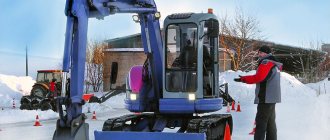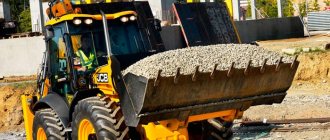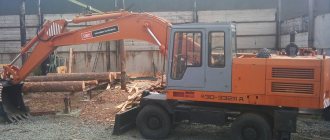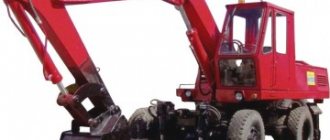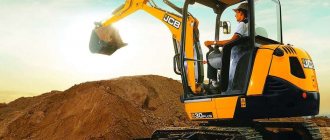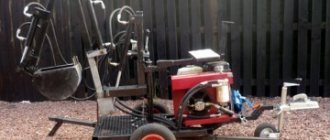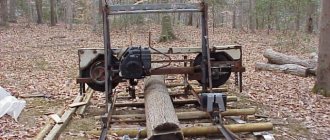Specialized training centers provide training for the excavator profession. To obtain a license for an excavator, you must not only master the principles of operating a technical device, but also have knowledge of the maintenance and repair of the base machine and its attachments, have the skills of a mechanic, be able to read drawings and diagrams of parts, and even understand the categories of soil.
The prestige of a profession is determined by its demand in the labor market. Excavators are in high demand. This special equipment is indispensable in the development of mine workings, quarries, and in the field of civil and road construction. Machines equipped with a bucket are used for digging trenches and pits or creating embankments and dumps, excavating soil or constructing dams. The machines are used not only for the extraction of iron ore, coal and other rocks, but also as loaders of bulk materials into vehicles.
A professional excavator operator is always provided with work and a stable income. And everyone with an excavator license can improve their rank over time by taking advanced training courses. The maximum professional level is 8th category.
Checking equipment before starting work
Regardless of his experience and experience with other types of forklifts, the operator must carefully study the operating instructions for the new model. After this, you should familiarize yourself with the control panel interface, the location of all levers and other controls. It is important to determine whether the functionality and capabilities of the excavator are suitable for the task at hand.
The driver can operate the excavator in two positions:
- facing forward . The controls are accessible as in any other tractor: steering wheel, clutch, brakes, gear lever, etc.;
- facing backwards . Controls for bucket, boom, stabilizers, etc. are available for use.
You should also pay attention to the additional functionality of the model. This includes the ventilation, air conditioning, all-wheel drive control, boom length and other capabilities. After this, you can begin to check the operator’s safety: safety belts, rollover protection functionality. This also includes auditing the integrity of hydraulic hoses, compliance of tire pressure with standards, the presence of a fire extinguisher and other protective equipment.
Where to train to become an excavator operator
Study programs to become an excavator operator were developed by the State Committee of the Russian Federation for Vocational Education. Now they are approved by regulations of the Ministry of Education.
Now you can learn to be an excavator operator or a forklift driver not only in vocational schools, but also in training centers and manufacturing plants.
All educational institutions that teach how to operate an excavator must have an appropriate production base for conducting practical training. The practical part of the exam must take place at a tractor track and on a specially prepared route.
Education
Persons who have reached the age of 18 and have no medical contraindications for study and further work are allowed to study the profession of an excavator. A medical certificate according to the established sample is issued on a paid basis. You must also present a certificate of payment of tax (state duty established by state technical supervision authorities).
Vocational training is carried out full-time and should include:
- theoretical classes in specially equipped classrooms;
- practical lessons;
- examination events with the participation of Gostekhnadzor inspectors.
Training programs for drivers of wheeled and tracked vehicles are drawn up taking into account the fact that, in addition to the skills of operating special equipment, the graduate will also acquire knowledge of vehicle maintenance and repair.
An excavator operator must be able to detect and troubleshoot problems, understand the operating principle of equipment, understand drawings, fuels and lubricants and their consumption rates, and know the basics of electrical engineering.
All this knowledge at the end of the course is checked by a certification commission, which must include a representative of Gostekhnadzor. The result of the certification is entered into the protocol. The excavator operator receives a certificate indicating the type of machine he is authorized to operate. The certificate is signed by the chairman of the examination committee.
In training centers, the course of study is designed for 300 or more academic hours and lasts from 2 to 4 months. The price is set by the centers themselves; in most educational institutions, obtaining the profession of an excavator operator costs about 7 thousand rubles, each subsequent increase in grade costs about 2.5 thousand rubles.
Increase in rank
After receiving a certificate, an excavator operator who has completed training for the first time has the right to operate a single-bucket machine with a volume of no more than 0.15 m³, since he is assigned a 4th category. To increase the rank, you will need to undergo training according to a shortened curriculum and pass an exam. Training for each higher level can be completed after a year of work with the previous qualification.
Increasing the rank indicates the professionalism of the driver. All categories and salaries of specialists are included in the unified tariff and qualification directory of jobs and professions. With each rank, wages increase, and the excavator operator receives permission to operate a more powerful machine in terms of bucket volume and productivity:
- 5th category - allows you to work with a bucket volume of up to 0.4 m³ and on trench rotary excavators with a productivity of up to 1000 m³/h;
- 6th category - bucket up to 1.25 m³, productivity - up to 2500 m³/h;
- 7th category - volume up to 4 m³, productivity up to 4500 m³/h;
- 8th category - volume up to 9 m³, productivity more than 4500 m³/h.
Powerful excavators are necessary in the mining industry, they are used in open-pit mines and coal mines. To work on such a giant, a driver needs professional education (courses will not be enough); he often works in tandem with an assistant, and a team of specialists handles the maintenance of large equipment.
Test operation
Once in the operator's seat, fasten your seat belts. After this, you can start the engine and let it warm up. The pillar, bucket and stabilizers should be off the ground at this time.
While sitting facing forward, you need to select the main bucket control lever. It's easy to use. If you push it towards yourself, the bucket will rise. To lower, you need to move the lever - the bucket will move down. Moving the control lever to the right will cause the bucket to scoop up soil, and in the opposite direction will cause soil or rock to be pushed away.
A word to innovation
After many manufacturers began to widely use electronics when equipping their model range, many electric drives began to be equipped with electric servo control using joysticks.
By the way, on the excavator.ru forum they recommend giving preference exclusively to servo control:
Depending on the joysticks, if they have a screw control then that’s great, but if they have an electric control then I can’t say anything about them, I know that the electric joystick quickly fails
If we analyze the offers on the market, we can see that in some cases joystick control is still an option, and in others it is an element of the basic configuration.
If we compare it with levers, the first advantage is the smaller amount of effort that needs to be applied in the process of performing a production task. This is very convenient and translates well into increased productivity.
Test digging
Before starting to move, you must release the handbrake and engage first gear. After the tractor is adjusted to the work site, you need to check the ground clearance. Using the throttle valve, the optimal engine speed is fixed: 850. The next step is to set the stabilizers. After completing the above steps, you can open the bucket.
When digging, the JCB backhoe loader is controlled in the following sequence. The main working body is brought to the place where the hole is to be dug. Using the left lever, the bucket is lowered to the ground, and the right one allows you to scoop up soil with the bucket. In the closed position it rises up. Next, the bucket moves to the dump site and opens using the right lever. To continue operation, the boom rotates to its initial position.
Operation of the hydraulic control system
This system has been intensively improved in recent years and has found wide application in the design of excavators, the mechanisms of which are driven by a single engine.
The design of the control system, based on hydraulics, has the main instruments and components:
- Pump. Operates at high pressure. Provides fluid movement in the hydraulic system. Powered by an excavator engine.
- A battery with a filter that acts as a temporary pressure tank when starting the engine.
- Distribution and return manifolds, control spools.
- Hydraulic cylinders that are located on mechanisms. Designed to turn mechanisms on and off.
Backhoe Loader Controls
In models with a simplified control system, one lever is used to manipulate the shovel (indicated by the letter A in the figure). There is a button B on the handle, which instantly disconnects the transmission from the power plant after pressing. Thanks to this, all the engine power will be redirected to the operation of the loader.
Raising and lowering the boom; rollback forward or backward is initiated by one lever according to the standard “+” control scheme for these cases. You can choose a combination of specific manipulations. To do this, the lever moves between four main directions. For example, in order to lift a shovel, the lever must be moved back. At the same time, if you move it to the left, the shovel rolls back.
That is, in cases where the control lever moves to the left and back, the shovel rises and rolls away. The speed of manipulation directly depends on the amplitude of movement of the lever: the more, the faster. The lever itself is equipped with a spring that allows it to return to its original position. The loader will remain locked in the selected position until the control lever is commanded to perform any operation.
Next to the control there is a label that provides complete information about the relationship between the movements of the lever and the response of the working bodies. We'll talk about them below.
Management of imported equipment
Now let's answer a detailed question: how to properly operate an imported excavator so as not to break it. First, you need to decide: what kind of hydraulic excavator you will have - small or large - you will need skills and training to operate it, but physical strength will not require precision. There will definitely be an instrument panel, like a good passenger car, which will provide the necessary information about all the operating parameters of the car. Present on it:
- Hours counting board
- Excavator fluid level
- Signal indicator - overheat warning
- Excavator battery charge
- Engine temperature
- Show oil pressure
- tachometer
The functions for controlling the excavator will be divided into two joysticks, one will be responsible for the movement in space of the excavator and the movement of the near part of the boom, the other for the operation of the bucket and the manipulator boom. No matter how difficult the work turns out to be, management will require practice, which can be obtained on a computer with a simulator program for this type of excavator.
You need to know that different types of excavators, depending on the manufacturer, have individual control schemes.
Return to digging position
The function is necessary in order to quickly switch to digging mode from the forward rolling position. If this mode is selected, the switch will cut off the oil pressure automatically at the moment when the shovel reaches the position required for digging.
In order to use the functionality, the “return to digging activation” switch (indicated in diagram A) should be moved to the “on” position. After the switch indication turns on, pull the control lever all the way to the left. The operator will feel a slight resistance when going through the roll back position. The lever must be released. It will remain in this position until the bucket reaches the desired position. And only after that it will automatically move to a neutral position.
If you no longer need to use a function, simply turn off the corresponding switch. Its indication will go out.
Safety precautions when moving an excavator
Look
All advertisements for the sale of crawler excavators
- The path along which the excavator will move must be leveled and planned in advance, and on soft soils reinforced with shields or flooring made of boards, beams or sleepers. As a rule, within the city and over long distances, the excavator must be moved on heavy trucks (trailers) or railway platforms.
- The descent and ascent of the excavator when moving it under its own power can be carried out on a road slope that does not exceed the maximum surmountable elevation angle of the excavator according to its technical passport.
- Lowering and lifting the excavator under its own power on a road slope exceeding that specified in paragraph 2 must be done with the additional help of a tractor or winch in the presence of a mechanic, workman or foreman.
- To cross bridges, pipelines, embankments and railway tracks, it is necessary to construct a crossing made of plates, sleepers or beams. The passage of an excavator through structures is permitted only after obtaining permission from the relevant organizations operating these structures. The transition should be carried out under the supervision of an engineer and technical worker.
- While the excavator is moving, its boom must be installed strictly in the direction of the excavator’s path, and the bucket must be raised above the ground to a height of 0.5-0.7 m, counting from the ground to the lower edge of the bucket. Moving an excavator with a loaded bucket is not permitted. The turntable must be braked.
- When an excavator passes under power line wires, the distance between the top point of the excavator in the transport position to the bottom wire of the active power line.
- If in fact the distance between the top point of the excavator and the bottom wire of the power line is less than specified in paragraph 6, then it is necessary to temporarily remove the voltage from this line. Any movement of an excavator near or under power line wires should be carried out in the presence of a representative of the organization operating this line.
Easy Controls System
On models equipped with Easy Controls, the loader attachment is controlled by a single lever (A). Its handle has a quick transmission reset button (B). Thanks to this, you can quickly free the power plant from additional load and direct all the power to do the job.
Individual movements – lowering, lifting, rolling away – are activated according to the standard “+” scheme. The combination of different movements is achieved by moving the control lever and holding it in the appropriate direction. For example, to roll forward and lower the shovel, you need to move the control to the right and forward. And vice versa, if you move the lever diagonally to the left and back, the shovel will roll back while lifting.
Excavation of soil with an excavator
Several stages include the excavator operating cycle:
- installing a bucket to repeat the cycle
- reverse platform rotation
- unloading bucket
- platform reversal
- soil cutting
The speed of work execution directly depends on the time it takes to complete one cycle, more than half of which is accounted for by turning the platform. Thus, reducing the angle of rotation of the platform significantly speeds up trench digging.
When cutting soil, the engine must be running at full power. The bucket should be immersed as close as possible, and its contents should be poured out at the farthest point of the car body or area, which is specially designated for the extracted soil.
The greatest efficiency is achieved when the digging depth allows the bucket to be fully loaded. The optimal digging radius (the distance from the body of the excavator itself to the point where the bucket is immersed) is approximately 70-90 percent of the maximum, which is indicated in the technical documentation.
To further reduce fuel and time costs, several operations are combined. For example, you can simultaneously rotate the platform while lowering the bucket for subsequent digging or raising the bucket for unloading.
Easy Controls system extended
An extended Easy Controls system is installed on a number of machines. They use the right lever to control the operation if the operating mode was selected using a rocker switch. If the seat is facing forward, control lever A can be activated using button C. To do this, press and release it. And to turn it off, just put the toggle switch in the central position. Pressing button C again will quickly disengage the transmission.
When the seat is facing rearward, toggle switch E should be moved to the loading position. To control the operation of the loader, press and hold switch C located on the right lever. At this time, a warning signal will sound. When the switch is released, the loader control is disabled and the warning signal stops.
The control lever can be used to give both separate commands according to the “+” scheme, and combined ones in the same order as described above.
Attachments
In most cases, the main attachment of a loader is a bucket. It is used for loading bulk cargo, moving, and storing. However, if necessary, special equipment can be supplemented with a fork part. The forks allow you to conveniently work with tared and palletized loads. Most forks are designed to move loads in an up/down direction. However, there are also models with a telescopic boom that can extend several meters forward. But even in such multifunctional options, ease of control of the loader is ensured. To operate equipment, you must have a state-issued “forklift operator” certificate with the required categories.

